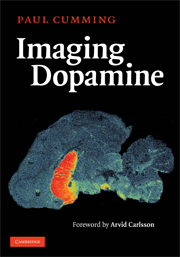Book contents
- Frontmatter
- Contents
- Foreword
- Acknowledgments
- Introduction
- 1 The life history of dopamine
- 2 Enzymology of tyrosine hydroxylase
- 3 The assay of tyrosine hydroxylase
- 4 Enzymology of aromatic amino acid decarboxylase
- 5 PET studies of DOPA utilization
- 6 Conjugation and sulfonation of dopamine and its metabolites
- 7 Dopamine synthesis and metabolism rates
- 8 MAO activity in the brain
- 9 Vesicular storage of dopamine
- 10 Dopamine release: from vesicles to behavior
- 11 The plasma membrane dopamine transporter
- 12 Dopamine receptors
- 13 Imaging dopamine D1 receptors
- 14 Imaging dopamine D2 receptors
- 15 Factors influencing D2 binding in living brain
- 16 The absolute abundance of dopamine receptors in the brain
- 17 Conclusions and perspectives
- References
- Index
- Plate section
14 - Imaging dopamine D2 receptors
Published online by Cambridge University Press: 04 December 2009
- Frontmatter
- Contents
- Foreword
- Acknowledgments
- Introduction
- 1 The life history of dopamine
- 2 Enzymology of tyrosine hydroxylase
- 3 The assay of tyrosine hydroxylase
- 4 Enzymology of aromatic amino acid decarboxylase
- 5 PET studies of DOPA utilization
- 6 Conjugation and sulfonation of dopamine and its metabolites
- 7 Dopamine synthesis and metabolism rates
- 8 MAO activity in the brain
- 9 Vesicular storage of dopamine
- 10 Dopamine release: from vesicles to behavior
- 11 The plasma membrane dopamine transporter
- 12 Dopamine receptors
- 13 Imaging dopamine D1 receptors
- 14 Imaging dopamine D2 receptors
- 15 Factors influencing D2 binding in living brain
- 16 The absolute abundance of dopamine receptors in the brain
- 17 Conclusions and perspectives
- References
- Index
- Plate section
Summary
General properties of D2 ligands
Irreversible ligands
N-[3H]methylspiperone ([3H]NMSP) is a butyrophenone compound binding to at least two pharmacologically distinct sites in homogenates from the mammalian brain. Although the bindings had similar kinetics in the caudate and in the cortex, the preponderance of binding in the caudate could be displaced with dopamine D2 antagonists, whereas most of the cortical binding was displaced with serotonin 5HT2 antagonists (Lyon et al. 1986). The in vitro association kinetics for both sites was rapid, while dissociation kinetics was so slow as to be nearly irreversible in the time course of a PET study. Displacement studies in living mice likewise revealed that whereas 90% of the [3H]spiperone binding in the frontal cortex was to serotonin receptors, 80% of the binding in the striatum was to dopamine D2 receptors (Frost et al. 1987). With the caveat that functional selectivity is mainly imparted by the differing distributions of the two main binding sites, [11C]NMSP and related compounds can potentially be used to measure dopamine and serotonin receptors in the same PET session (Borbely et al. 1999).
Displacement studies of [3H]spiperone from rat brain membranes indicated the presence of considerable amounts of non-dopaminergic, non-serotonergic sites, although these were of ten-fold lower apparent affinity than were the identified components of the binding (List & Seeman 1981).
- Type
- Chapter
- Information
- Imaging Dopamine , pp. 174 - 202Publisher: Cambridge University PressPrint publication year: 2009



